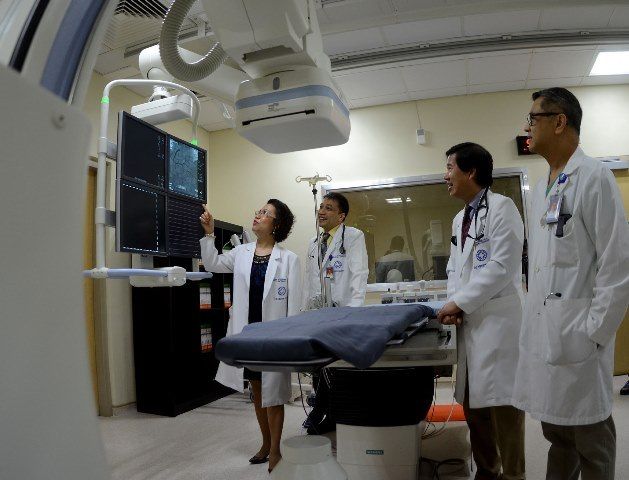(From left) Dr. Olympia Q. Malanyaon, Head, Section of Pediatric Cardiology; Dr. Michelangelo L. Sabas, Interventional Cardiologist; Dr. Gregorio S. Martinez, Jr., Head, Cardiac and Vascular Catheterization Laboratory and the Cardiovascular Center, and Dr. Donato R. Maraon, Interventional Cardiologist show off the TMC Cath Lab’s state-of-the-art multi-purpose imaging system
The Medical City Cardiac and Vascular Catheterization Laboratory (TMC Cath Lab) has recently expanded its capabilities. The Cath Lab has acquired its second Artis Zee, a state-of-the-art multi-purpose imaging system. The equipment allows for clearer, more accurate images of the arteries of the heart, brain, internal organs, and limbs. In 2013, the Cath Lab performed more than one thousand coronary procedures, more than any other Cath Lab in a private institution in the country. With the addition of a second imaging system, the TMC Cardiovascular Center hopes to address the treatment of cardiovascular emergencies in a more effective and timely manner. Interventional cardiologists can perform longer vascular procedures without compromising access to an emergency procedure if needed.
“Those who depend on us to take care of their cardiac patients can continue to rely on us for excellent care,” says Dr. Gregorio Martinez, Jr., Head of the Cardiac and Vascular Catheterization Laboratory and the Cardiovascular Center. Dr. Martinez clarifies that responding to cardiac cases, especially heart attacks, is time sensitive. Delays in treating a heart attack patient impact on the size of the damage to the heart muscle, and ultimately on the patient’s prognosis. Prompt diagnosis and right treatment within the specified time frame is vital.

(From left) Dr. Olympia Q. Malanyaon, Head, Section of Pediatric Cardiology; Dr. Michelangelo L. Sabas, Interventional Cardiologist; Dr. Gregorio S. Martinez, Jr., Head, Cardiac and Vascular Catheterization Laboratory and the Cardiovascular Center, and Dr. Donato R. Maraon, Interventional Cardiologist show off the TMC Cath Lab’s state-of-the-art multi-purpose imaging system
“The TMC Cardiovascular Center has an Acute Myocardial Infarction Program which targets a 90 minute Door-to-Balloon time. This means that a heart attack patient who walks through the doors of our emergency room should have the blocked coronary artery opened in the Cath Lab within 90 minutes. TMC’s expanded Cath Lab capacity, backed by experienced and highly competent interventional cardiologists and support staff who are trained to handle such complex cases, can assure patients of the best possible and the most timely cardiac care,” explains Dr. Martinez.
“The expansion of TMC Cath lab will raise the bar for cardiac care at The Medical City,” says Interventional Cardiologist Dr. Michelangelo Sabas. “Adding a second Cath Lab system not only provides us with the latest technology but will also allow us to care for more patients and reduce the backlog of patients waiting for diagnostic testing. It enables us to care for multiple urgent care patients at once. We can see more patients with less disruption of patient care with this second Cath Lab system.”
Interventional procedures done in the TMC Cath Lab are minimally invasive treatments where doctors use catheters, introduced through a small skin puncture, to access the heart, the coronary arteries, the arteries to the brain and various organs in order to treat abnormal conditions. Furthermore, the TMC Cath Lab offers state of the art technology for coronary angiography and angioplasty, valvuloplasty, pacemaker implantation, peripheral vascular angiography and angioplasty, embolization procedures, cerebral angiography and coiling of intracerebral aneurysms.
It has enhanced capabilities for Fraction Flow Reserve (FFR), Thrombectomy (AngioJet), and the visualization of implanted stents (CLEARstent). FFR measurements, which are done during the angiogram procedure, help identify lesions that restrict blood flow to the heart and therefore serve as accurate guides on whether a borderline narrowing should be opened up with a stenting procedure. Thrombectomy is a procedure to extract blood clots and therefore restore blood flow to arteries and veins clogged with clots (thrombus), while CLEARstent is a stent visualization enhancement tool that makes possible the placement of stents in complex coronary angioplasty.
The TMC Cath Lab is the leading Cath Lab in the country for coronary angiography and angioplasty via radial artery approach. Angioplasty via the radial artery approach makes use of the wrist artery instead of the groin artery as access. This enables patients to go home the same day after the procedure and resume their normal activities the next day. Approximately nine out of ten coronary procedures in the Cath Lab are done via the wrist artery.
“At the TMC Cath Lab, we have a comprehensive range of cutting-edge equipment that can be utilized for more accurate diagnosis and effective and safer treatment. At The Medical City, we treat each patient not as a ‘case’ but as a unique individual who deserves the best informed medical care. This is why acquiring technology which can give us a clearer, more accurate assessment of each patient’s individual case is paramount,” says Dr. Martinez.